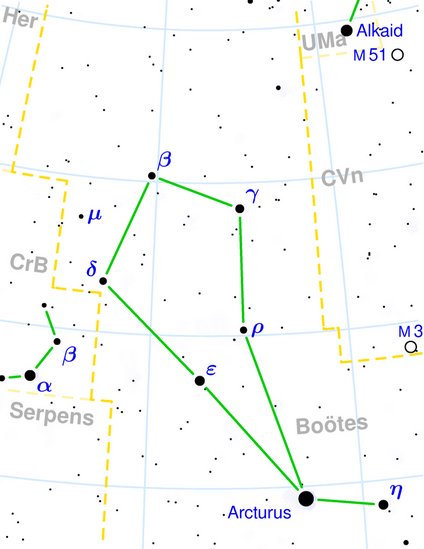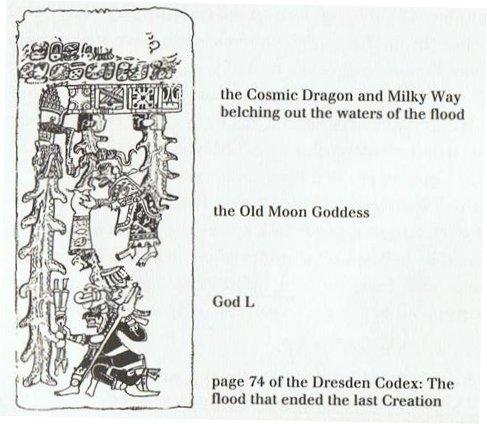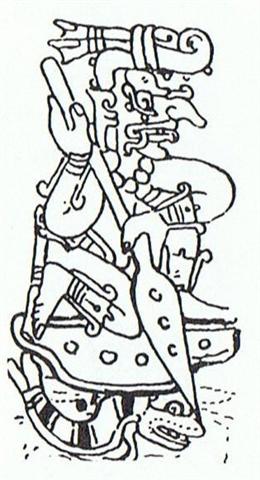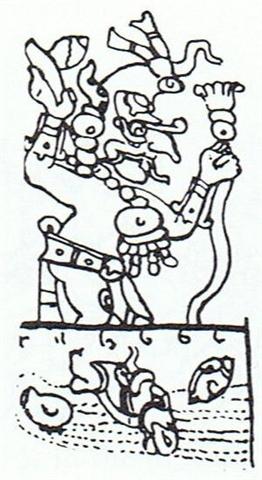Once again. When the Sun reached η Bootis (Muphrid) it may have been like a Sign for him to leave (kua oho) the northern hemisphere. Because now it was the Full Moon's turn to be at the Front of the Head of Ku, at the Babylonian station Mahrū-sha-rishu-ku. In rongorongo times this happened in October 17, in day 290, and 5 days later came Arcturus:

However, the simplified map above does not
include the essential ξ, which
was marking
the right leg of the Bootes:


|
Egyptian
djed |
 |
Phoenician
sāmekh |
 |
Greek
xi |
Ξ
(ξ) |
|
... In rongorongo times
the last Greek lettered star
in Orion (ξ)
rose with the Sun in June 21. The letter seems to have
originated from the Phoenician letter samekh
(tent peg, supporting prop), which in turn may have been
derived from the ancient Egytian djed column ...
 |
The distance from
ξ Orionis to ξ Bootis was
224.5 - 92.5 = 132 days. 132 = 11 * 12 = 366 - 18 * 13. Number
13 was probably essential for the creators of the rongorongo
texts. For instance was 57 * 13 = 39 * 19 = 741 equal to the
number of glyph positions on the C tablet (zero + 392 + 348).
The Full Moon was at the
Back of the Head of
Ku (Arku-sha-rishu-ku) when the Sun
had reached his star of exit (π)
in the Water
Serpent:
|
٭JULY
31 (212) |
 |
|
Ca2-1 (27) |
|
Te heke |
|
MUPHRID
(210.1), ζ Centauri (210.3) |
|
October 17 (290) |
|
NAKSHATRA DATES: |
|
٭JANUARY
29 (395 = 29 + 366) |
|
Al Sharatain-1 /
Ashvini-1 /
Bond-16 /
Mahrū-sha-rishu-ku-1 |
|
Segin,
Mesarthim,
ψ Phoenicis (27.2),
SHERATAN,
φ Phoenicis (27.4) |
|
April 17 (473 = 107 + 366) |
|
٭AUGUST
1 |
2 (214) |
3 |
4 (*136) |
5 |
 |
 |
 |
 |
 |
|
Ca2-2 |
Ca2-3 |
Ca2-4
(30) |
Ca2-5 |
Ca2-6 |
|
erua tagata |
te henua |
tagata oho ki tona
huaga |
kua oho |
|
φ Centauri (211.0), υ¹ Centauri
(211.1), υ² Centauri (211.8), τ
Virginis (211.9) |
Agena (212.1), θ Apodis (212.5),
THUBAN
(212.8) |
14h (213.1) |
Neck-2 |
Al Ghafr-13 /
Svāti-15
TAHUA-TAATA-METUA-TE-TUPU-MAVAE |
|
π HYDRAE,
χ Centauri (213.0), Menkent (213.1) |
ASELLUS TERTIUS,
κ VIRGINIS,
14 Bootis (214.8) |
15 Bootis (215.2),
ARCTURUS
(215.4),
ASELLUS SECUNDUS
(215.5),
SYRMA,
λ Bootis (215.6), η Apodis (215.8) |
|
October
18 |
19 |
20 |
21 |
22 (295) |
|
NAKSHATRA DATES: |
|
٭JANUARY
30 |
31 |
٭FEBRUARY
1 |
2 |
3 |
|
ι
Arietis (28.0), λ Arietis (28.2), υ
Ceti (28.8) |
ALRISHA,
χ Phoenicis (29.2), Alamak (29.7) |
Arku-sha-rishu-ku-2 |
η
Arietis (31.9) |
no
star listed (32) |
|
2h (30.4) |
|
κ
Arietis (30.3),
HAMAL
(30.5)
ALKES
|
|
April 18
(108) |
19 (*29) |
*30 + 366 = *396 |
*214 + 183 = *397 |
22 |

The 13th Arab station
coincided with day 295 (October 22) and
its name Al Ghafr meant the
Covering. Like when in the evening a
black cloth is thrown over the bird cage
to make him quiet.

Then should follow the
rest of those 40 nights which were ending at the
6th Chinese station Tail, when
the rainy season should have ended (gone
away, kua oho):
 |
 |
 |
 |
 |
30 |
|
Ga5-1 (111) |
Ga5-2 |
Ga5-3 |
Ga5-4 |
Ga5-5 |
|
JULY 10 |
11 |
12 (193) |
13 |
14 |
|
θ Crateris (175.0), υ Leonis
(175.2), ω Virginis (175.3),
ι Crateris (175.5) |
ο Hydrae (176.1) |
ζ Crateris, ξ Virginis
(177.0), λ Muscae (177.1), ν
Virginis (177.2), μ Muscae
(177.8) |
Al Sarfah-10 /
Uttara Phalguni-12 /
Zibbat A.-16 /
Shēpu-arkū sha-A-17 |
Phekda, β Hydrae (179.3), η
Crateris (179.9)
Deneb Cygni |
|
93 LEONIS
(178.0),
DENEBOLA
(178.3),
ALARAPH
(178.6) |
|
September 12 |
13 (256) |
14 |
15 |
16 |
|
NAKSHATRA DATES: |
|
JANUARY 9 |
10 |
11 |
12 |
13 (378) |
|
λ Piscium (358.0),
MANUS CATENATA
(358.1), Alrai, θ Phoenicis
(358.4), κ Andromedae
(358.7) |
ω Aquarii (359.2), 78 Pegasi
(359.5) |
ψ Andromedae (360.1), σ
Phoenicis (360.4) |
γ¹ Oct. (361.4). φ Pegasi
(361.7) |
Dzaneb (362.4), γ²
Oct.(362.8) |
|
π |
March 15 |
16 (440) |
17 |
18 (77) |
 |
 |
 |
 |
 |
 |
37 |
|
Ga6-6 |
Ga6-7 |
Ga6-8 |
Ga6-9 |
Ga6-10 (150) |
Ga6-11 |
|
AUGUST 14 |
15 |
16 |
17 (229) |
18 |
19 |
|
MUPHRID
(210.1), ζ Centauri (210.3) |
φ Centauri (211.0), υ¹
Centauri (211.1), υ²
Centauri (211.8), τ Virginis
(211.9) |
Agena (212.1), θ Apodis
(212.5),
THUBAN
(212.8) |
14h (213.1) |
Neck-2 |
Al Ghafr-13 /
Svāti-15
TAHUA-TAATA-METUA-TE-TUPU-MAVAE |
|
π HYDRAE,
χ Centauri (213.0), Menkent
(213.1) |
ASELLUS TERTIUS,
κ VIRGINIS,
14 Bootis (214.8) |
15 Bootis (215.2),
ARCTURUS
(215.4),
ASELLUS SECUNDUS
(215.5),
SYRMA,
λ Bootis (215.6), η Apodis
(215.8) |
|
October 17 |
18 |
19 |
20 |
21 |
22 (295) |
|
NAKSHATRA DATES: |
|
FEBRUARY 13 |
2-14 (45) |
15 |
16 |
(413 = 14 * 29½) |
18 |
|
ι Arietis (28.0), λ Arietis
(28.2), υ Ceti (28.8) |
ALRISHA,
χ Phoenicis (29.2), Alamak
(29.7) |
Arku-sha-rishu-ku-2 |
η Arietis (31.9) |
no star listed (32) |
θ Arietis (33.3),
MIRA
(33.7) |
|
2h (30.4) |
|
κ Arietis (30.3),
HAMAL
(30.5)
Alkes
|
|
April 18 (108) |
19 (*29) |
20 (475) |
21 |
22 |
23 |
|
٭SEPTEMBER 12 |
13 (256 = 4 * 64) |
14 (*177 = 6 * 29½) |
15 |
16 |
 |
 |
 |
 |
 |
|
Ga7-20 |
Ga7-21 |
Ga7-22 (191) |
Ga7-23 |
Ga7-24 |
|
SEPTEMBER 26 |
27 (270) |
28 |
29 |
30 (*193) |
|
Atria (253.9) |
Tail-6 |
ι Ophiuchi (255.3),
Grafias
(255.4) |
κ Ophiuchi (256.2), ζ Arae
(256.5), ε Arae (256.8),
Cujam (256.9) |
no star listed (257) |
|
Wei,
η Arae (254.3),
DENEBAKRAB
(254.7) |
|
November 29 |
30 |
December 1 |
2 (336) |
3 |
|
NAKSHATRA DATES: |
|
٭MARCH 14 (73) |
15 |
16 |
17 |
18 |
|
MARCH 28 |
29 |
30 |
31 (90) |
APRIL 1 |
|
Tabit (71.7), π² Orionis
(71.9) |
π4 Orionis (72.1), ο¹
Orionis (72.4), π5 Orionis
(72.8) |
π¹ Orionis (73.0),ο² Orionis
(73.4),
HASSALEH
(73.6), π6 Orionis (73.9) |
Almaaz (74.7),
HAEDUS I
(74.8) |
HAEDUS II
(75.9) |
|
May 31 |
June 1 |
2 |
3 |
4 (155) |
Day 336 (December 2) was 14 * 24
days from January 1 and 336 - 80 =
256 (= 16 * 16) could possibly have measured
out the length of the year before
the 'deluge'.
 |
 |
 |
 |
 |
35 |
|
Ga5-1 (111) |
Ga5-2 |
Ga5-3 |
Ga5-4 |
Ga5-5 |
|
MANUS CATENATA |
|
|
DENEBOLA |
Deneb Cygni |
|
March 14 (3-14) |
39 = 3 * 13 |
|
























